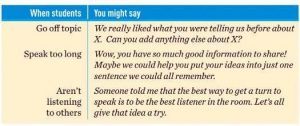
Question: I’d like to stop monopolizing the lessons I offer. Ideally, I want my classes to have better student participation. Any ideas for help? — B.F., Astoria, New York
LEE DANESCO RESPONDS…
Dear B.F.: If you consistently teach via the monologue method, children can draw the unfortunate conclusion that the lesson belongs to you. By monopolizing the speaking role in every lesson, you inadvertently pull the plug on student interest and involvement. You keep talking, but they stop listening. Fortunately, yours is not the only voice available to help roll out the lesson each week. Sitting right in front of you are potential assistants — students ready and waiting to generate excitement, curiosity, and participation. All you need to do is invite them to take up a more active speaking role!
Elements of change
Involving new voices in the classroom doesn’t need to be difficult, but it does require your commitment to a certain mindset. Before you investigate where or when to include the voices of students, focus first on the three attitudes you’ll need to adopt and display to make this change work for everyone.
1. Openness
Committing to regular, vocal student participation requires a willingness to explore what lies beyond your comfort zone and to enthusiastically welcome student voices into the sevelopment of each lesson. For you that means making minor alterations in lesson plans to create new speaking options for students.
What will that openness sound like to your students?

Each time you use these kinds of simple sentence revisions to invite even one student to speak his or her thoughts, credit yourself with enriching the lesson and building student confidence. By openly applauding the vocal sharing of student ideas, you encourage even reluctant students to become more involved.
2. Patience
Don’t be surprised to find that most students will enjoy new opportunities to speak during class. In fact, some children will be so pleased at the sound of their own voice, they may find it difficult to limit their remarks, stay on topic, or listen to what others have to offer. At those junctures, you’ll need to match your attitude of openness with a patience that keeps order without dampening enthusiasm.
Using your own brand of kindly redirection, you can gently steer children to make constructive additions to the lesson in a courteous manner with comments like these:

3. Respect
Collectively, your tone of voice, facial expression, body language, and the words you speak have the power to convince children that you value what they say and how their words improve the quality of each lesson. Respecting their contributions should include your honest appreciation of and support for student efforts.
These sample responses to student participation can help you to strike the right note.
“Thanks for sharing your idea. You’ve given all of us something to think about this week.”
“After hearing that very unique answer, I’ll be calling on you again, soon.”
“For me, that really puts a completely different spin on things!”
A place for student voices
Marked by an attitude of openness, patience, and respect for student participation, you’re ready to be on the lookout for where, when, and how you can maximize constructive student input.
 Excerpted from Change It Up by Lee Danesco. 2017. Published by Twenty-Third Publications, (TwentyThirdPublications.com). Used with permission. All rights reserved.
Excerpted from Change It Up by Lee Danesco. 2017. Published by Twenty-Third Publications, (TwentyThirdPublications.com). Used with permission. All rights reserved.
EDITOR’S NOTE: This excerpt has been modified to fit this format.
Lee Danesco has served in catechetical ministry for more than 20 years. She is the author of many books and articles, including Change It Up! and Here’s How: A Catechist’s Guide (Twenty-Third Publications).
This article was originally published in Catechist magazine, November 2019
PH0TO: BY WAVEBREAKMEDIA/SHUTTERSTOCK




